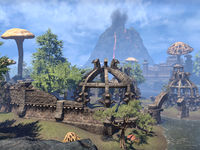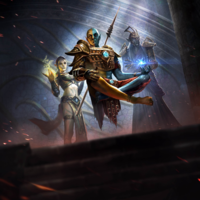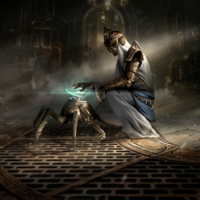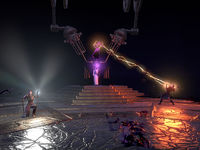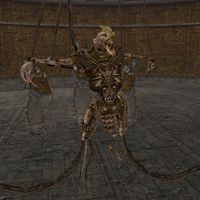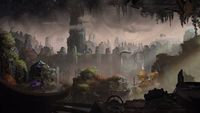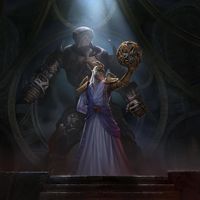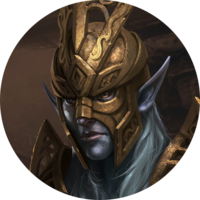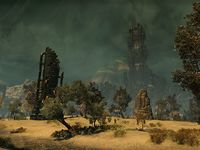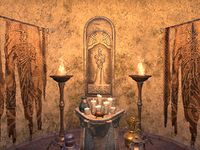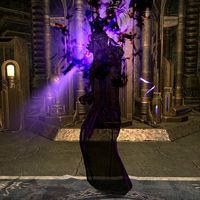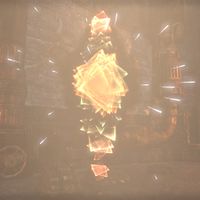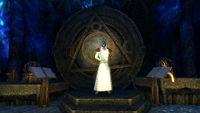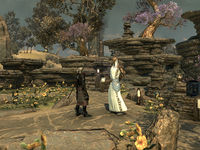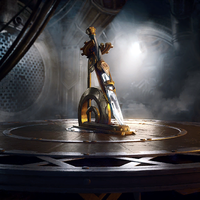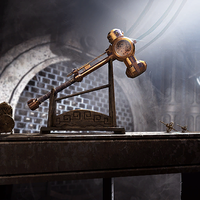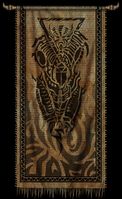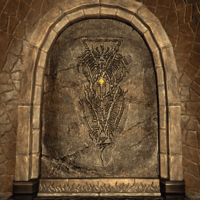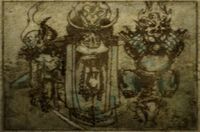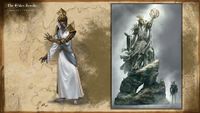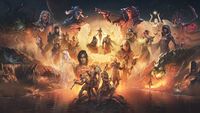Lore:Sotha Sil
This article is about the god. For the city, see Clockwork City.
—Sotha Sil
| Sotha Sil | |||
|---|---|---|---|
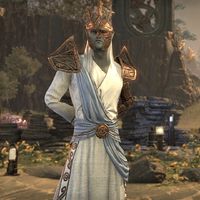 Sotha Sil
Sotha Sil |
|||
| Race | Dunmer (formerly Chimer) | Gender | Male |
| Born | 1st Era Ald Sotha |
||
| Died | 3E 427 Clockwork City |
||
| Resided in | Clockwork City Resdayn |
||
| Appears in | Tribunal, ESO, Legends | ||
Sotha Sil, or Seht, wizard-mystic god of the Dunmer and "Si" in the AlmSiVi, was the most enigmatic member of the divine Tribunal. He was known as the Mainspring Ever-Wound,[1][2] the Father of Mysteries, Magus[3], the Magician[4], the Teacher[5], the Sorcerer, the Tinkerer, the Clockwork God, the Light of Knowledge[3], the Inspiration of Craft and Sorcery[3], the God of the World Mechanism[3], the Clockwork King of the Three in One[6], patron of artificers and wizards[3], and the architect of time and a binder of Oblivion.[7] He did not believe himself to be a god, but did not deprive Vivec and Almalexia of their joy of being acknowledged as one.[8] He also did not acknowledge free will, believing himself bound to creating his greatest invention, the Clockwork City. Those that followed the faith of the Tribunal Temple knew him for his power as well as the knowledge he provided, and for his contribution to helping the former Chimer transition into their Dunmer identity.[9] He also had faithful within the Clockwork City, where his Clockwork Apostles followed the sermons of Deldrise Morvayn and devoted their work towards one goal: achieving Tamriel Final, a new Nirn.[10][11] With the rise of the New Temple in the Fourth Era, Sotha Sil and the rest of the Tribunal were demoted to "saints and heroes", and the three Good Daedra retook their place as the center of worship for the Dunmer as "the Reclamations".[12][13]
Aside from his Clockwork City, another major part of Sotha Sil's legacy was the creation of the Coldharbour Compact between himself and eight Daedric Princes. Its terms are unknown to others, but it is believed it prevented the Daedric Princes from participating in mortal affairs directly,[14] although it has been violated at times.[9] He was the creator of a number of artifacts, and of various entities such as the factotums and fabricants that populated his realm.[15][16] He also developed advanced metallic prosthesis which could replace one's limbs. Sotha Sil believed that "the truth of clockwork is for all", but his followers took measures to ensure his creations did not fall into the wrong hands.[9]
Biography[edit]
Early Life[edit]
Sotha Sil was born a Chimer in the town Ald Sotha, in what is now known as the island of Vvardenfell, in the Ascadian Isles region.[17] Ald Sotha was the seat of House Sotha, a minor house of the settled Chimer in the early First Era. He was known to have had a mother, whose name was lost to history, and a sister, Sotha Nall.[18][19]
Excerpts from his memories provide clues to the nature of his upbringing, such as that his family was composed of well-off nobles and that he was raised by a number of maternal figures including his lenient mother, rebellious sister, and kind nanny. The town of Ald Sotha is recounted as a tranquil place, with a fish pond, flower garden with many birds, artisanal kitchens, and many sunny days with activities involving pottery wheels, catching torchbugs in jars, and eating scrib jelly on rainy days.[20] In one of his preserved memories, Sotha Sil's mother or nanny comforted a young Sil after he had sustained a knee abrasion, using the childhood nursery tale of the Brave Little Scrib to inspire him with courage, as his sister sang him a lullaby.[21] Another memory from his childhood involved him and his sister taking care of a dead bird by burying it in a handkerchief.[20] A memory from his young adulthood involved his sister, Nall, trying to convince a reluctant Sil to enter a forbidden area.[21]
In the fable "Sotha Sil and the Scribs" from the Homilies of Blessed Almalexia, a young Sotha Sil was playing in a Kwama egg mine as a child, and seeing a number of scribs in a deep shaft, he began to cast stones upon them for amusement, snickering as they skittered and scattered. One scrib lifted its head up and begged Sotha Sil to stop, telling him "Please, please, have mercy, little boy, for what is sport to you is suffering and death to us." when they were hit by the stones. This taught the young boy that what are idle amusements of one can be solemn tortures for another.[22] Another homily titled "Sotha Sil and the Stars" tells of young Sotha laying down and gazing at the stars at night. In his passion for maths, Sil decided to count every star and give each of them a name for hours on end, eventually falling asleep. When he awoke, he saw that the stars had vanished, and began to weep, learning the lesson that time cages all tasks.[23] These tales were evidently well-known in Morrowind as Nilvyn Omaren compared Dunmer slavery to the child-Seht who "makes sport of suffering".[24]
With unknown motives, the Daedric Prince Mehrunes Dagon arrived in Ald Sotha during Sotha Sil's youth and destroyed it, killing everyone in it including Sil's family.[19][25] It occurred at some point after he and his sister traveled to the forbidden area near the town, and took place upon a rainy morning. His family woke up to find their homes and tapestries already burning, and screamed in agony in their final moments.[20] Sotha Sil was the sole survivor of the attack, having been saved by Vivec.[17][18] House Sotha was wiped out save for Sotha Sil, and he continued to use their name.
The first sermon of The Thirty-Six Lessons of Vivec contradicts this claim, placing Sotha Sil as older than Vivec. It tells of sometime before the Skyrim Captivity, the Demiprince Fa-Nuit-Hen appearing to a Velothi tribeswoman, the wife of a Chimer netchiman, who had been impregnated with an egg by the dreugh before being brought to Azura's Coast by Sotha Sil. The egg contained the unborn Vivec, and seven Daedra known as the Barons Who Move Like This appeared before the woman to teach the egg new swordsmanship motions. When Fa-Nuit-Hen appeared, he told the netchiman's wife to seek the Hortator in the land of Indoril before combining with the Barons to form a terrible pillar of fighting styles and teaching Vivec.[6] Fa-Nuit-Hen himself verifies the sermon's claims to a degree, stating that he did in fact meet Vivec in his youth, and made an impression on him.[26]
Friendship with Nerevar and Advisor of the First Council[edit]
—Nerevar to Sotha Sil
At the time Indoril Nerevar and Dumac Dwarfking repulsed the Nords in 1E 416, Sotha Sil was Nerevar's teacher and one of his closest advisers.[27] Nerevar's junior counselor and other teacher was Vivec, and Sotha Sil acted as a mentor for them both[27] By negotiation and compromise, Nerevar and Dumac somehow managed to preserve a fragile peace, prolonging the alliance brokered to fight the Nords. Sotha Sil, always doubted that such a peace might long survive given the bitter disputes between Chimer and Dwemer.[27]
Dumac Dwarfking gifted Sotha Sil a wing of Kemel-Ze as a sign of the alliance between their two peoples.[28] Sotha Sil used this facility to do preliminary work on his lifelong project, the Clockwork City. There he studied the flora and fauna of Nirn to learn how to replicate their functions with metal and energy.[29]
At one point, he built the Precursor, also called the "Oscillating Son", the first factotum, a mechanical construct heavily influenced by Dwemer. However, unlike Dwemer automatons, the Precursor possessed a rudimentary form of artificial intelligence. Various crystals, known as Integrals, gave the Precursor the knowledge of mathematics, the ability to use logic and reason and even the ability for self reflection.[30]
In Kemel-Ze, he used Mnemonic Fragments to store some of his memories in an early factotum called Protus. He sought to use the memories to create an artificial animus. But all he was able to achieve was the appearance of a fully developed soul,a convincing lie—artificial projection of himself.[8] In this laboratory, he also created the Clockwork Probabilis to manipulate the Intrinsic forces that govern events on Nirn. Some of those forces are constant—like the force which compels objects to fall to the ground—while others defy prediction and categorization. The Clockwork Probabilis is a prototype, a precursor to the Throne Aligned, the control center of the future Clockwork City.[8]
Sotha Sil participated in the War of the First Council, which started when Voryn Dagoth of House Dagoth learned of a Dwemer scheme: deep in the bowels of Red Mountain on the island of Vvardenfell, the Dwemer had found the Heart of Lorkhan, and High Craftlord Kagrenac planned to harness it and use it to power a giant mechanical god.[27][31] Lord Dagoth reported this to the Chimer leadership, and eventually, the Hortator Nerevar confirmed it with his patron Azura. Nerevar confronted his friend Dumac, and they quarreled bitterly. As a result, Nerevar led the Chimer to war in order to stop this "profane" usurpation.[27][31] During the war's famed Battle of Red Mountain, Vivec asked Sotha Sil to come up with some plan to help stop the Dwemer's Automatons from slaughtering the Chimer.[21] Out of necessity, Sotha Sil created an army of Clockwork Dreugh that were inspired by Dwemeri war machines, to be used against the Dwemer. They were said to have risen up from the seas and took their counterparts to the water beneath to be swallowed by the sea.[32]
After Nerevar's death, the councilors of Nerevar and the Tribunal of Vivec, Almalexia, and Sotha Sil came to power among the Dunmer. They then went against Nerevar's dying wish by using the profane Tools of Kagrenac on the Heart of Lorkhan in order to steal its divine essence for themselves, becoming gods to the Dunmer people. The event led to the Daedric Prince Azura cursing the Chimer, turning them all into the Dunmer. As Azura rebuked the Tribunal, it was Sotha Sil who replied that her time as a god was over, and that the Tribunal as the new gods would be wise and caring of the needs of their people.[27] Sotha Sil was one of the few who can resist Azura's curse but chose to remain with his Dunmeri appearance.[21] He would aid in the transition of his people into the Dunmer, getting them to accept that it was not a curse but a blessing, and that they were new Mer, civilized and able to speak directly to their patrons, the Tribunal.[31]
The Clockwork God's Ambitions[edit]
After the rise of the Tribunal at the Battle of Red Mountain in the First Era, to achieve a balance between the material and spiritual world, Sotha Sil focused on mastering both magic and technology.[33] The Clockwork City was a magical and mechanical wonder created by him for various reasons, all of which were to serve a noble goal. He saw the Aedra's creation of Nirn as flawed and in order to perfect it,[UOL 1] he built the Clockwork City to ensure the redemption of Tamriel, unify competing forces, and destroy the Daedra.[34] During the genesis of the city, Sotha Sil's vision of a self-contained world made of brass and machinery was very ambitious and he developed highly advanced methods to see it through. He created the Celestiodrome, which surrounds the entire realm in the form of a glass globe which is perceived by the realm's inhabitants as its sky. The Celestiodrome is capable of mimicking both a day and night cycle,[35] and the rotating girders installed on it allows for proper topography to be formed within the Realm.[21] In an effort to make the Clockwork City habitable, Sotha Sil sought to achieve the proper humidity needed for a breathable atmosphere for his realm.[21] He created the Halls of Regulation, which maintained the city's water cycle, breathable air, humidity, temperature, wind currents, as well as creating drinkable water.[36]
He drew inspiration from the Dwemer, and their influence in his work is rumored to be traceable as far back as before the disappearance of the Dwemer.[32] Among these influences was his research on Dwemer tonal architecture. He refined it further and created items based on their research, such as tonal forks that could function as a divining rod.[37] He also worked with Dwemer constructs, tinkering in ways beyond the capabilities of even the most talented individuals.[38][39] Sotha Sil created the humanoid automatons known as factotums to maintain the Clockwork City.[15] Early variants were built with a design that resembled Dwarven automatons and were constructed from both Dwemer and clockwork parts.[40] Ultimately his style became his own and the city's structures, vegetation, and wildlife are all mechanical constructs of his own design.[16]
Sotha Sil would go on and create part organic, part inorganic creatures known as fabricants, [41] which are rumored to be the first step towards the convergence of Nature and engineering.[16]
Sotha Sil would later become dissatisfied with the potency of regular Soul Gems as power sources for his ambitious designs, and would seek to improve upon them. One such iteration was the Animus geode, but their uses were still limited.[21] In the case of his Factotums, he eventually came up with the animo core—a brass vessel that utilized a soul gem in some manner.[42] Later, Sotha Sil would seek to uncover the secrets to everlasting life, and was the first to reverse engineer soul gems into Black Soul Gems.[43] He used the aging Temple Saints, Felms, Olms, and Llothis as test subjects, transferring their souls into Black Soul Gems, with Factotum bodies as vessel. Like others whose have transferred their souls into Factotum vessels, they went insane, causing the study of Black Soul Gems to be banned by the Clockwork Apostles.[44]
Towards the end of the First Era, around 1E 2920, Sotha Sil spent some time on the Isle of Artaeum, where he taught some of the new mages of the Psijic Order.[45] While there, Sotha Sil also further studied the Dwemer's creations, as well as further refined his clockwork creations.[46] He left some of his creations behind when he departed back into the Clockwork City.[47][48]
The Coldharbour Compact[edit]
In response to the destruction of Gilverdale at the hands of Molag Bal, Sotha Sil journeyed into Oblivion via the Dreaming Cavern and made a pact between the 3rd and 5th of Rain's Hand in 1E 2920, with eight of the more prominent Daedric Princes: Azura, Boethiah, Hermaeus Mora, Hircine, Malacath, Mehrunes Dagon, Molag Bal, and Sheogorath.[49] Known as the Coldharbour Compact, the exact terms of this agreement are unknown to the inhabitants of Nirn and Oblivion.[50] It is theorized that it prevents the Princes from directly manifesting on Nirn. It is also speculated that, in order to secure the agreement of the Princes, Sotha Sil either made a credible threat to them or presented a significant offer in exchange.[51][34] They were only permitted to commune with certain intermediaries, such as witches and sorcerers.[49]
Mehrunes Dagon's general attitude towards the Coldharbour Compact was that of indifference. To him, Sotha Sil was a mere mortal mechanist that was to be crushed like he did his childhood home, and no compact was to keep him from destroying Nirn.[52] This sentiment would manifest a few months later in Sun's Dusk of 1E 2920. The Skeffington Coven of High Rock took in an exiled Dunmeri woman named Turala, the former lover of the Duke of Mournhold, Brindisi Dorom.[53] However, after a trip to Wayrest, the Skeffington Coven was massacred by an Orcish raiding party. Turala was falsely led to believe that the massacre was the work of assassins sent by Brindisi Dorom himself. Enraged, the witch called forth the Prince of Destruction to destroy Mournhold and slay her former lover, and he complied.[54]
During the carnage, Sotha Sil arrived with Almalexia to Mournhold, and engaged him in the battlefield that was lit by a barrage of flame which fell indiscriminately. Almalexia plunged Hopesfire into Dagon's flesh and carved him from within. Meanwhile, Sotha Sil, enacting vengeance for Ald Sotha, used "god-bronze whips" to lash the Prince into submission. Wounded, Sil allegedly whispered Dagon's Nymic, and the Prince "exploded throughout all time".[25][55] After his banishment, Sotha Sil sealed the planar doors between Nirn and the Deadlands, blocking off all access for Dagon as further punishment for breaking the Coldharbour Compact.[50]
Second Era[edit]
Around 2E 582, Nocturnal tried to take control of the Clockwork City. She summoned Sotha Sil's Shadow, who replaced him as ruler of the Clockwork City. Meanwhile, one of the Clockwork Apostles, Chancellor Gascone Dusant, sought to deliver the Skeleton Key, which had been accidentally found by a Factotum beneath the Brass Fortress, to Clavicus Vile, only for the Key to be stolen by the Blackfeather Court. The Vestige, assisted by Divayth Fyr and the Clockwork Apostles, unveiled the plot, but were unable to reclaim the Skeleton Key before it was taken by Sotha Sil's Shadow. Using the key, Nocturnal and the Shadow attempted to seize control of the Clockwork City, but were stopped by the Vestige, Divayth Fyr, and Proctor Luciana Pullo, who rescued Sotha Sil by defeating his Shadow. Sotha Sil then gave the Skeleton Key to Divayth Fyr for safekeeping.[56]
Sotha Sil became involved directly in the affairs of the Nirn, when Nocturnal subsequently tried to take control of the Crystal Tower. Using a technique she stole from Sotha Sil involving utilizing life energy as a power source, she planned to use the life energy of Nirn, and then the energy of the other Daedric Princes afterwards, to amplify the Crystal tower to make her power limitless. Nocturnal's plan was foiled by the Psijic Order and the Vestige, with the assistance by the two betrayed Princes (Mephala and Clavicus Vile) and the champion of Meridia known as the Golden Knight. The divine power of Meridia's Dawnbreaker was then used to restore the tower's stone, Transparent Law. Sotha Sil then made negotiations with both Mephala and Clavicus Vile and the two have agreed to a compact to put an end to their direct meddling.[57]
In 2E 882, when the Tribunal visited Red Mountain for their annual pilgrimage to replenish their divine power, the reawakened Dagoth Ur and his minions ambushed them and drove them away after nearly killing them.[58] The event resulted in the Tribunal being cut off from access to the Heart of Lorkhan, and caused Sotha Sil to respond by beginning development of a replacement heart. His solution was the Mechanical Heart, a mechanical replication of the Heart of Lorkhan, to act as a new source of divinity and as new power source for his Clockwork City.[59] The development would not go smoothly, as The Heart became unstable in its early development, and to prevent the Heart from destroying the City, he created his own variant of Kagrenac's Tools to control, shape, or even dismantle the Heart if necessary. [60] Sotha Sil went to great lengths to keep the Heart from those who would misuse it. He stored it within the Chamber of Lorkhan, located deep in the Clockwork City's Cogitum Centralis. Sotha Sil also hid his tools as a precaution across Nirn to prevent people from stealing the Heart's power.[61]
The Tribunal were able to kill Dagoth Ur and his kin after this initial setback, but they were always revived by the Heart. To contain them, the Tribunal erected the Ghostfence around Red Mountain.[62]
Third Era[edit]
Sotha Sil once spent time counseling, guiding, and protecting mortals, loving them perhaps more than either Vivec or Almalexia.[4] He is said to have felt the stress of each of his people, but assigned them no more load than he knew they could bear.[7] Sotha Sil's traumatizing childhood may be one of the first factors that contributed with his deteriorating mental health. Him being the only survivor of his House being destroyed by Mehrunes Dagon[18] may be why one of his goals was to destroy the daedra.[34] His ascension into godhood was accompanied by a silence described as coming from a place of grief and deep regret,[63] evidently from his betrayal of his oath to Indoril Nerevar.[21] His lifework, the Clockwork City, was created to serve as a world-shaping device, but he felt sorrow from it being built on betrayal and untold horrors.[34]
In time, Sotha Sil became detached from the real world. He gradually lost touch with the affairs of the Dunmer, the rest of the Tribunal, and eventually all of Tamriel.[64] His obsession with perfecting his Clockwork City, and the fact that its functions is very dependent on his presence,[65] was one of the contributing factors that would ultimately cause him to become distant, reclusive, and would lead his participation with mortal affairs to dwindle. His last known participation of mortal affairs was in 3E 417, when after centuries of becoming weaker and more desperate, Sotha Sil and Almalexia lost two of Kagrenac's Tools, Keening and Sunder, to Dagoth Ur's forces. Vivec rescued them, but they could not recover the stolen Tools and had to flee Red Mountain.[58]
Before his total seclusion, despite predicting they would not meet again centuries prior,[34] Sotha Sil would have one of his final conversations with his peer Divayth Fyr, in which they discussed the disappearance of the Dwemer, his divine nature, and the location of his city among other things.[UOL 2] Sotha Sil continued developing the Mechanical Heart, but its progress would be threatened as the day arrived, just as he predicted, where his friend Almalexia would come to kill him.[66][67] In 3E 427, the goddess Almalexia, having been driven mad by her loss of immortality, manipulated the Nerevarine to retrieve Barilzar's Mazed Band, which she used to travel to the Clockwork City to murder Sotha Sil in cold blood. When Almalexia came face to face with Sotha Sil, he said not one word, making her think that even in death, Sotha Sil mocked her with silence.[4] In reality, he was likely in another state of mind and was unable to respond, a result of being plugged into the control center within the Dome of Sotha Sil.[67] In his final moments, he attempted to use his control center to seal the Chamber of Lorkhan to prevent the Heart from falling into the wrong hands and to ensure the City would live on after his death. He was successful in sealing the Chamber and his machines began finishing the construction of the Mechanical Heart within it.
After murdering Sotha Sil, Almalexia transported his fabricants into Mournhold to wreak havoc. She then tricked the Nerevarine into going to the Clockwork City to kill the late Sotha Sil, who she blamed for the attacks. Once there, she attempted to murder the Nerevarine as well, but her divine powers had waned, and as a result, she wasn't powerful enough and was struck down.[68]
Legacy[edit]
—Sotha Sil
Azura claimed that her anticipation shed his mortality long ago, and that his death was likely no small relief to him.[69] The majority of the populace seemingly did not know of Almalexia's betrayal to her fellow tribune and would attribute the death of Sotha Sil to the Nerevarine.[70] When he came to say farewell to a mortal known as the Scribe, Sotha Sil claimed that after he was gone it is possible another who looked much like him may come to play his role in a new tale.[71] Much later, when the Provisional House was in ruin and the Tribunal faced its end, Vehk described Seht as having his belly swollen with his daughter who was born to fulfill the task he could not. While Sotha Sil died at the hands of Almalexia, this cosmic child survived him.[72][73][UOL 3] His body was retrieved by Vivec, who interred him and Almalexia in the proper Velothi fashion.[UOL 3]
Sotha Sil's Clockwork City would continue to be powered by the Mechanical Heart after his death. The Mechanical Heart finished being fully constructed by his machines 207 years after his death in 4E 201.[67] However, stories tell of a Forgotten Hero who followed a former Clockwork Apostle, Mecinar, into the city to prevent the latter from claiming the Heart's power. The fate of the Clockwork City since is unclear- some stories suggest the City was destroyed alongside the Mechanical Heart,[74] while others suggest the hero preserved both the Heart and the City while still stopping Mecinar.[75][76]
The Clockwork Apostles survived long after Sotha Sil's death, with a Dunmer known as Galyn the Shelterer keeping the faith alive within the confines of the Clockwork City, but their fate was unknown after Mecinar's machinations.[77] The Dunmer back in Tamriel itself returned to the veneration of Azura, now called one of the "Reclamations", and managed to make their way without their Clockwork God watching over them. Sotha Sil is still remembered and honored as one of the greater saints of the Dunmeri faith,[12] but not one who was ever supposed to be one of the cornerstones of the religion.[78]
Despite the majority of the Dunmer people turning away from Tribunal worship, Sotha Sil was still revered by certain sects. These devotees were regarded as heretics by the New Temple and were persecuted for their beliefs.[79] One such cult constructed a hidden temple in a cave on Solstheim known as Ashfall's Tear, just north of Raven Rock. The cultists raised a giant statue to Almalexia and planned to use old propaganda to restore widespread Tribunal worship.[80][81] Circa 4E 201, the Last Dragonborn was alerted to the cult's existence, although it is unknown if the Dragonborn aided the cult or destroyed it.[80]
Artifacts[edit]
Keening, Sunder, and Wraithguard II[edit]
The loss of the Heart of Lorkhan led Sotha Sil to develop his own version of it, the Mechanical Heart. To siphon the Mechanical Heart's power, Sotha Sil created his own variants of Kagrenac's Tools to control, shape, or even dismantle it if necessary. He foresaw his eventual death at the hands of Almalexia, and eventually hid his tools as a precaution across Nirn to prevent the Heart's power from being stolen. The location of the tools was lost after his demise—though some tales describe a Forgotten Hero reclaiming them Circa 4E 201.
Mechanical Heart[edit]
The Mechanical Heart, also referred to as the New Heart of Lorkhan, is a mechanical replication of the Heart of Lorkhan created by Sotha Sil. It first began development shortly after the events that occurred in 2E 882, where Dagoth Ur awakened and then ambushed and nearly killed the Tribunal during their annual pilgrimage to Red Mountain to renew their divine powers. The event resulted in the Tribunal being cut off from access to the Heart of Lorkhan, and the Mechanical Heart project would be conceived by Sotha Sil as a backup to ameliorate the loss of the original Heart of Lorkhan.
Mask of Sotha Sil[edit]
The Mask of Sotha Sil is the blessed mask (also known as the killing mask) of the Tribunal god Sotha Sil. It embodies his idea for a Anuvanna'si (Tamriel Final), whose one of many goals was where life would undergo a synthesis of organic and non-organic nature (akin to the Fabricants). Indeed, overtime, Sotha Sil's body would become more and more synthetic, and his mask also changed to undergo this transformation. His followers, the Clockwork Apostles, mimic this synthesis with modifying their bodies, as well as craft their headwear in the Clockwork God's image.
It is one of the Masks of the Tribunal, the other two being Almalexia's War Mask, and Vivec's Ash Mask.
Seht's Affect Inducer[edit]
Seht's Affect Inducer is a device that could manipulate a person's emotions. Created by Sotha Sil, the device was originally entrusted to Barilzar.
Sunna'rah[edit]
Sunna'rah is a powerful staff-like device created by the clockwork god Sotha Sil. Also referred to as the "blessed staff", it combines clockwork technology with magicka. It was used by Sotha Sil to study his divine powers. By draining minute pieces of his own energy into a reservoir, he could study it and then return the energy back into himself.
Gallery[edit]
See Also[edit]
Books[edit]
- A Brief History of Ald Sotha by Varlinsi Arandu, Apostle of Sotha Sil — A short account of Sotha Sil's early life
- The Truth in Sequence by Deldrise Morvayn, Fourth Tourbillon to the Mainspring Ever-Wound — Sermons on the metaphysics of Sotha Sil
References[edit]
- ^ The Truth in Sequence: Volume 1 — Deldrise Morvayn
- ^ Lector Trivura's dialogue in ESO: Clockwork City
- ^ a b c d e The Living Gods — Durillis the Theologian
- ^ a b c Almalexia's dialogue in Morrowind: Tribunal
- ^ The Cantatas of Vivec
- ^ a b 36 Lessons of Vivec, Sermon 1 — Vivec
- ^ a b Servant of Sotha Sil's dialogue in ESO
- ^ a b c Sotha Sil's dialogue in ESO
- ^ a b c Loremaster's Archive - The Clockwork City — Proctor Tarvus
- ^ The Unseen Potential of Clockwork — Lector Saelorn Tenar, Apostle of Sotha Sil
- ^ The Truth in Sequence — Deldrise Morvayn, Fourth Tourbillon to the Mainspring Ever-Wound
- ^ a b The Reclamations — Thara of Rihad
- ^ Elder Othreloth's dialogue in Skyrim: Dragonborn
- ^ Azura's dialogue in ESO
- ^ a b The Mystery of Factotums — Associate Zanon, Clockwork Apostle
- ^ a b c What is the Clockwork City? on the official ESO website
- ^ a b Tholer Saryoni's dialogue in Morrowind
- ^ a b c A Brief History of Ald Sotha — Varlinsi Arandu, Apostle of Sotha Sil
- ^ a b The Factotum's Secret Voice — Lector Tidras Dran, Clockwork Apostle
- ^ a b c Factotum ambient dialogue in ESO: Clockwork City
- ^ a b c d e f g h Star's dialogue during The Astronomer's Apprentice in ESO: Clockwork City
- ^ Homilies of Blessed Almalexia — Almalexia
- ^ Blessed Almalexia's Fables for Evening
- ^ Omaren Trial Transcript — Nilvyn Omaren
- ^ a b The Truth in Sequence: Volume 8 — Deldrise Morvayn
- ^ Fa-Nuit-Hen's dialogue in ESO: Orsinium
- ^ a b c d e f The Battle of Red Mountain — Vivec
- ^ Thoryn Armas' dialogue in ESO
- ^ Protus' dialogue in ESO
- ^ Construct's Integral of Calculus, Introspection and Reason items in ESO
- ^ a b c Nerevar at Red Mountain — the Tribunal Temple
- ^ a b 36 Lessons of Vivec, Sermon 36 — Vivec
- ^ The Elder Scrolls V: Skyrim Tarot Deck and Guidebook Temperance Card, pg 41
- ^ a b c d e Sotha Sil's dialogue in ESO: Clockwork City
- ^ Provost Varuni Arvel's dialogue in ESO: Clockwork City
- ^ The Clockwork City Adventure Guide on the official ESO website
- ^ Divaricated Tone Fork item description in ESO
- ^ Divayth Fyr's dialogue in ESO: Morrowind
- ^ Appearance of Refabricated Arquebus, Refabricated Spider, Refabricated Centurion, and Ordinated Protector in ESO
- ^ The Precursor's dialogue in ESO: Clockwork City
- ^ The Truth in Sequence: Volume 6 — Deldrise Morvayn
- ^ Energetic Animo Core furnishing item in ESO
- ^ Asylum Sanctorium loading screen in ESO: Clockwork City
- ^ Alienist Llandras' dialogue in ESO: Clockwork City
- ^ 2920, Evening Star — Carlovac Townway
- ^ Psijic Brassilisk pet description in ESO
- ^ Sotha Sil's Study in ESO: Summerset
- ^ Oriandra's dialogue in ESO: Summerset
- ^ a b 2920, Rain's Hand — Carlovac Townway
- ^ a b Lyranth's dialogue in ESO: The Deadlands
- ^ The Coldharbour Compact
- ^ Transcribed Words of Mehrunes Dagon
- ^ 2920, Hearth Fire — Carlovac Townway
- ^ 2920, Frostfall — Carlovac Townway
- ^ 2920, Sun's Dusk — Carlovac Townway
- ^ Events of ESO: Clockwork City
- ^ Events of ESO: Summerset
- ^ a b Dagoth Ur's Plans — Tribunal Temple
- ^ The Red Mountain quest in Legends
- ^ Sotha Sil's dialogue during The Tools in Legends
- ^ Galyn's dialogue during The Throne Aligned in Legends
- ^ Vivec's dialogue in Morrowind
- ^ Divayth Fyr's dialogue in ESO: Clockwork City
- ^ Mehra Helas' dialogue in Morrowind: Tribunal
- ^ Luciana Pullo' dialogue in ESO: Clockwork City
- ^ Aios' dialogue in ESO: Clockwork City
- ^ a b c Sotha Sil's dialogue during The Last Stand in Legends
- ^ The Mad God quest in Morrowind: Tribunal
- ^ Azura's dialogue in Morrowind
- ^ Pocket Guide to the Empire, 3rd Edition: The Temple: Morrowind — Imperial Geographical Society, 3E 432
- ^ Sotha Sil and the Scribe — Andrunal, Seer of Verse
- ^ The Nine Coruscations — Star-Queen Varalias
- ^ 36 Lessons of Vivec, Sermon 37 — Vivec
- ^ Kellen's dialogue during The City Falls in Legends
- ^ Kellen's dialogue during Journey's End in Legends
- ^ Events of Return to Clockwork City
- ^ Galyn the Shelterer's dialogue in Legends
- ^ Galdrus Hlervu's dialogue in Skyrim: Dragonborn
- ^ Heretic Dossier: Blacksmith's Confessional
- ^ a b Ghosts of the Tribunal quest in Skyrim: Creation Club
- ^ Her Word Against Theirs quest in Skyrim: Creation Club
Note: The following references are considered to be unofficial sources. They are included to round off this article and may not be authoritative or conclusive.
|
|||||||||||
|
|||||||||||||||||||||||
